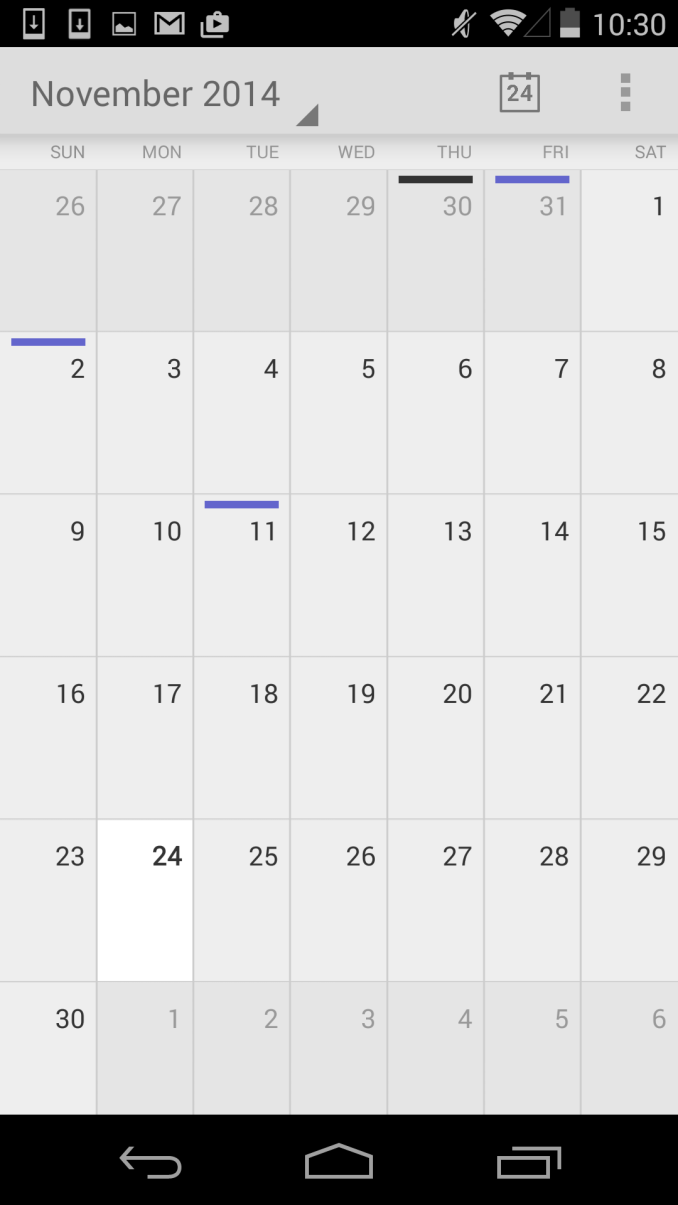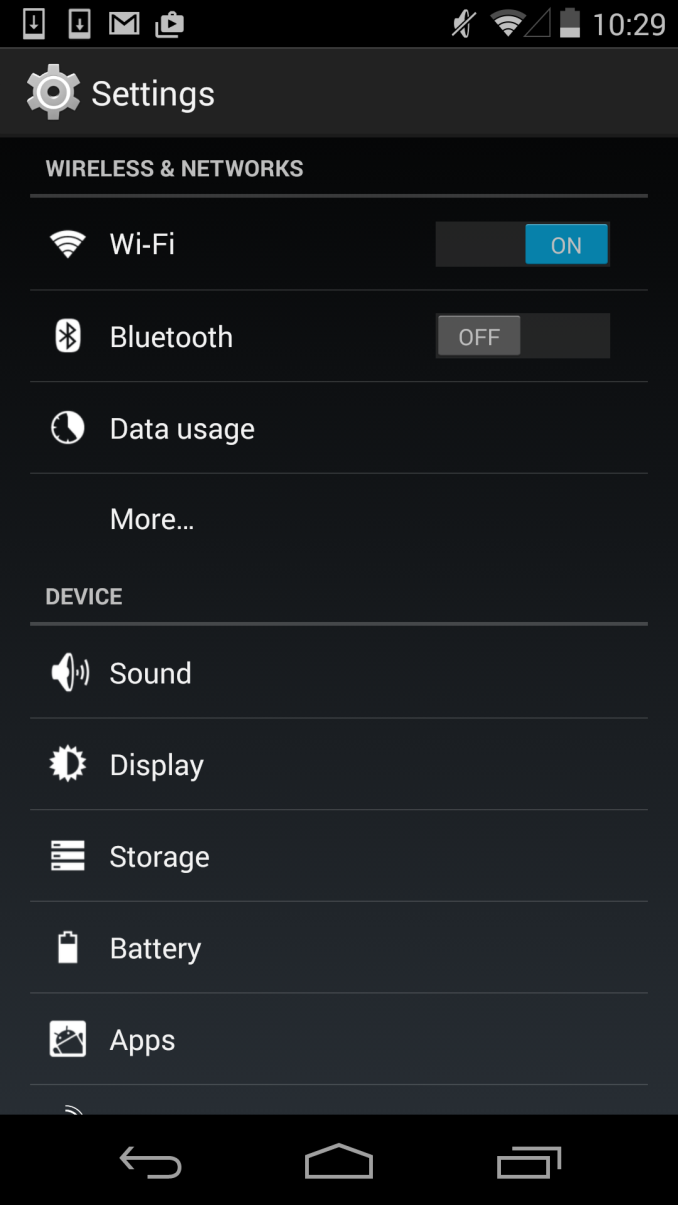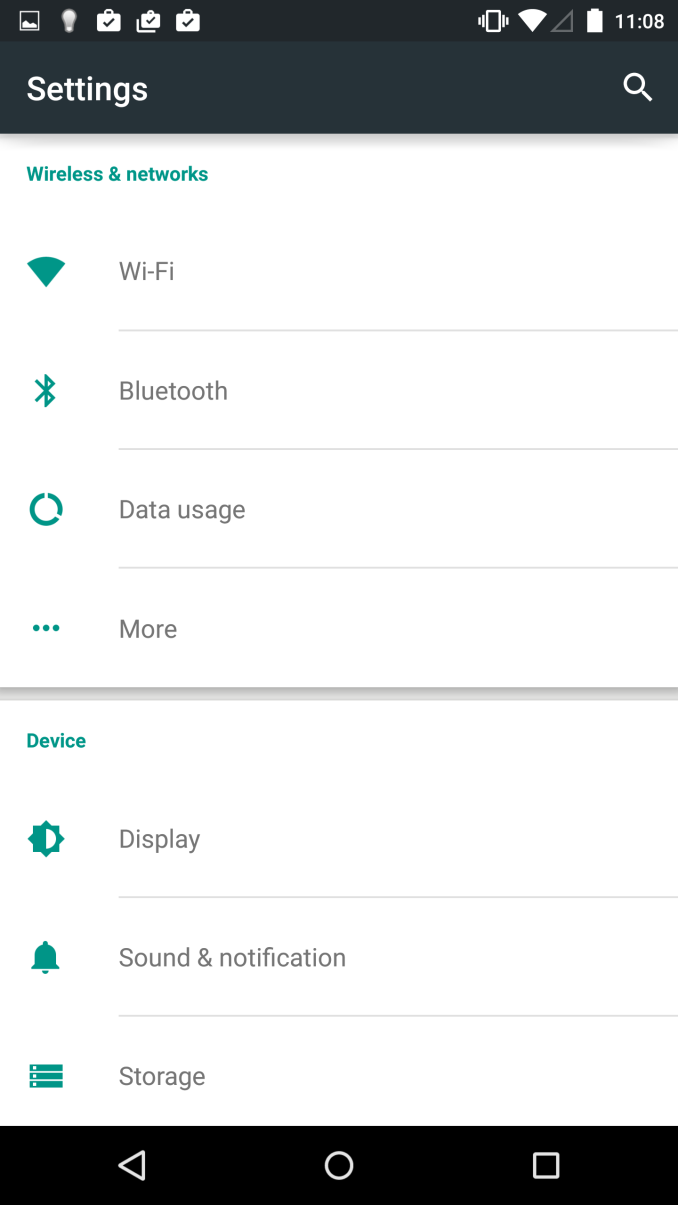The Android 5.0 Lollipop Review
by Brandon Chester on December 1, 2014 10:00 AM EST- Posted in
- Smartphones
- Android
- Tablets
- Android 5.0
Material Design
A good place to begin before discussing the operating system itself is to explain what exactly "Material Design" is. The term comes up a lot throughout the course of the review, which makes sense given how the biggest changes that users will see when moving from KitKat to Lollipop will be because of Material Design. Material Design is a set of design principles, and contained within them is something of a mission statement about Google's approach to services across multiple platforms. Material Design is definitely not Google's first big change to the Android interface, but this time I'm actually very confident that it will be the last we see for a very long time. I'm very impressed by the work Google has done to create an interface that looks and feels modern, simple, and beautiful. Before getting into what Material Design looks and acts like, I'd like to address and give my thoughts about Google's previous style of interface design which was called Holo.
To me, Holo always seemed like a transitional type of interface. Google had just brought on Matías Duarte, but as someone whose first smartphone was a Palm Pre, I didn't feel his influence anywhere at all. I think that Holo was a definite improvement over the previous Android interface, but that isn't really saying much. In my opinion, it still didn't feel coherent or look visually appealing. For example, if you showed me the two screens above without the status bar and navigation buttons, I would be hard pressed to tell you that they're from the same operating system. They don't share a single common interface element. The lack of color and use of grey was also questionable. While some users protest the heavy use of white in many modern interfaces, to me the grey that was commonly used in Holo Light applications was analogous to a dirty white cloth. The lacking color also made applications feel rather dull and lifeless, and I almost wondered if it was an effort to try and mask the fact that phones were shipping with either under-saturated or over-saturated displays by just having almost no color at all.
With my disappointment in Google's new interface, I was worried that it would just be something I would have to deal with for many years. Fortunately, less than one year after Android Ice Cream Sandwich was released, we were given a glimpse of the beginnings of a new type of design that was distinctly not Holo. It was in a feature called Google Now which launched with Android 4.1, and that many people now use everyday. This application used bright white cards to display relevant information, and had a much heavier use of color than any other applications that shipped along with Android. While at the time this could have been dismissed as the most obvious way to make an application that is constantly displaying and updating information for the user, in hindsight it was clearly the beginning of a new type of design being practiced at Google. It was still immature, lacking the animations, drop shadows, and dynamic nature of Material Design, but it began the dissolution of the Holo interface that had just been introduced.
Finally with the end of Holo, comes the beginning of Material. When Google gave a sneak peek of the new interface for Lollipop at Google IO I was very excited by what I saw seeing. The basic idea of the cards in Google Now had been applied to the entire operating system, and expanded upon in ways that I hadn't expected but have been pleasantly surprised by. As you can see above, both applications display the sections of the interface on white cards that float above the background and cast slight shadows. There's also a much greater use of color, and a better use of screen real estate by dividing the application into multiple sections which can be seen in the new Calendar application. The Settings application is actually a bad example in this regard, as the increased spacing means the main page fits less on screen than before, but this is an exception and I included it primarily to show the contrast between new and old.
Material Design is based upon the ideas of paper, lighting, shadows, depth, and color. While this sounds a lot like the skeuomorphic interface of previous versions of iOS, Material Design doesn't limit itself based on the actual limits of physical items like paper, and it doesn't go to the point where applications are merely digital recreations of real world objects. There's also a heavy use of animations. Everything you touch seems to respond with an elegant animation, and the different cards in the interface can expand, contract, and stack atop one another to create an extremely dynamic feel. It is truly hard to explain, and it's really something that needs to be used to be fully understood.
The last thing to say about Material Design is how it represents more than just a way to design applications. Like I said earlier, within Material Design is a mission statement about Google's approach to services across multiple platforms. Although I've discussed it within the context of the Android platform, Material Design is going to be what you see in Google's applications across every platform. From web apps, to Android, to Chrome, to iOS applications, you will see a consistent style of design that adapts to different display sizes, use models, and methods of input. Overall this is a great step forward in making Google's services consistent across all devices, but I think in the context of iOS applications Google may be going a bit too far by ignoring the design guidelines of that platform in favor of their own.














126 Comments
View All Comments
blzd - Monday, December 1, 2014 - link
Sounds like your just avoiding change. That's fine, but the rest of us would like to move on. No one forces you to update, thankfully it's there for those who want it.jwcalla - Monday, December 1, 2014 - link
The good thing about "change" is that it comes about every six months in this industry now. So if he's not thrilled with this look, he can just hang on because Android 6.0 "with all-new Unmaterial Design!" is just around the corner.tuxRoller - Tuesday, December 2, 2014 - link
Settings>accessibility>color inversionwhiteiphoneproblems - Monday, December 1, 2014 - link
"I think in the context of iOS applications Google may be going a bit too far by ignoring the design guidelines of that platform in favor of their own."I agree!
chris3145 - Monday, December 1, 2014 - link
"iOS had previously resorted to intrusive alerts that displayed in the middle of the screen and interrupted the user."How could you bring that up and then not say anything about Android's heads up notifications that have the exact problem?
mostlyharmless - Monday, December 1, 2014 - link
So, now that screen resolution is higher and processors more powerful, they're moving to minimalist design!? I like the old icons better.Arnulf - Monday, December 1, 2014 - link
Wow Brandon Chester, you are a dumbfuck noob. Pardon my online gaming terminology but this article reads like a whining post from one of those mongoloid little kids who are too dumb to grasp the basis of a game, so they cry and cry and some more and then finally rejoice when a tiny spec of their stupidity is made insignificant by the UI change,Seriously, have you considered moving to iOS platform if you're too stupid for 4.4.x's appearance? At least you won't have to trouble yourself with the issues have been facing here as somebody else will be doing the thinking for you.
Arnulf - Monday, December 1, 2014 - link
Kingdom for an Edit function !!! "Speck", of course, and some punctuation.RickRussellTX - Monday, December 1, 2014 - link
The design aesthetic of tiny text surrounded by tons of unused white space cannot die soon enough.I bought a phone and a tablet with fantastic screen resolution, so I can finally display a useful amount of text without compromises. Now I can't display more than a few lines of anything because the UI won't let me. Dates and times on your e-mail? Sorry, no room Inbox for that!
toyotabedzrock - Monday, December 1, 2014 - link
I think the ui is inconsistent and the usability is down. The button placement in apps is nice to look at but not nice to use everyday.The notifications now intrude onto the screen for some apps, the lock screen is less useful without additional dragging that takes dexterity to do right. And having to drag down twice is much more difficult than pressing a button. It is as if no typical consumer testing was done.
The task switcher is so sluggish and going back home now takes much longer. Everything seems to use more memory and takes longer to start which is odd. And I have a Nexus 5.
I hope 5.1 comes soon.